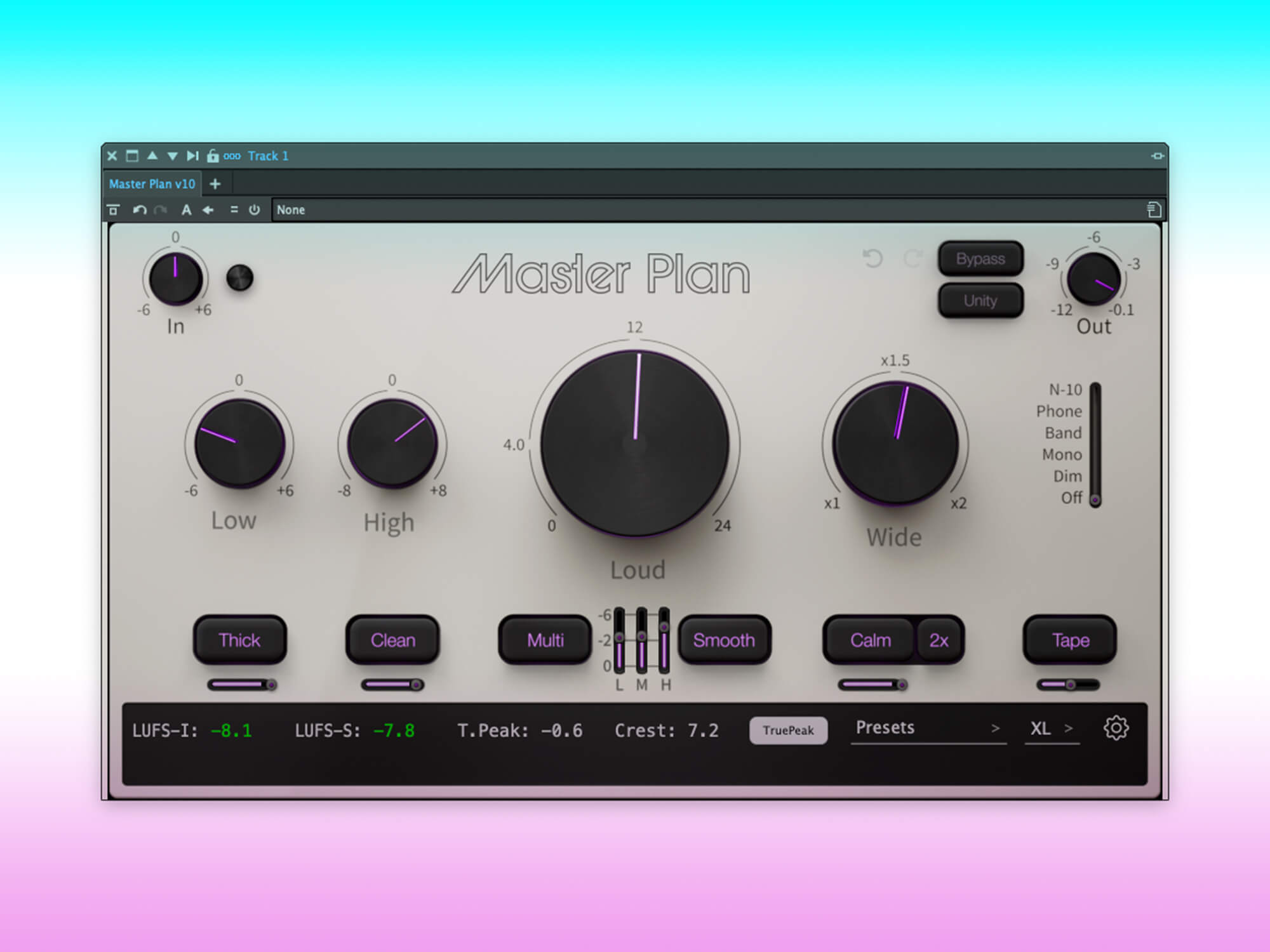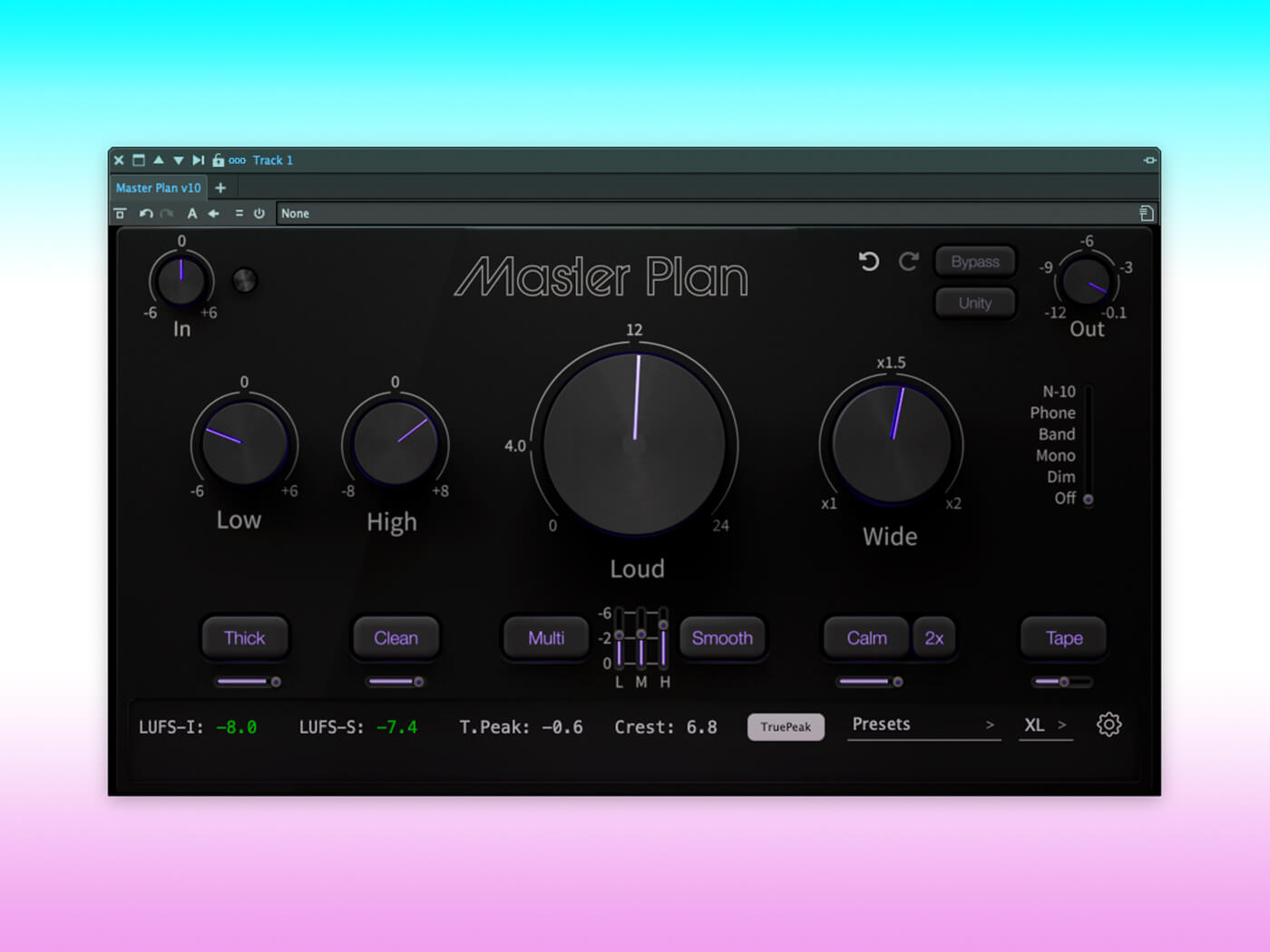Musik Hack Master Plan plugin: Mastering isn’t supposed to be this easy
The technical business of mastering can be a chore if you’re focusing on crafting awesome music, but Music Hack may have a Plan that will help…

Musik Hack Master Plan (light mode)
Review Overview
Our rating
8
Our verdict
⊕ Ridiculously simple to configure
⊕ Impressive control of peaks and true peaks
⊕ Surprisingly deep control over sonic details
⊕ Unity feature eases comparison with dry audio
⊖ A choice of EQ corner frequencies would increase flexibility
⊖ Absence of graphic loudness meters
Perpetual: $175 ($89 offer until 31st May 2024)
Rent-to-own: 5 x $35 (5 x $18 offer until 31st May 2024)
musikhack.com
The tools and processors involved in mastering are similar to those in mixing, but they also tend to be pricier, more nuanced and more complex. Plus, they’re used in a way that’s quite different to the techniques we learn to use when mixing.
As a result, we’ve seen a significant uptick in the number of all-in-one mastering solutions coming to market. That includes AI-driven online services through to conventional mastering plugins that hide the complexities of mastering behind simplified controls.
- READ MORE: dSONIQ’s Realphones 2.0 offers a realistic and affordable one-stop solution to headphone mixing
Master Plan from Musik Hack falls squarely into the latter bracket, packing a full mastering chain into a single plugin with just a handful of large, welcoming, and intuitive controls.
What is Master Plan?
At the centre of Master Plan – both figuratively and literally – sits the big, chunky Loud dial. This controls an underlying limiter/clipper circuit that can deliver an astonishing loudness boost while never letting the audio exceed 0dB-FS.
At lower settings, the boost is pleasingly clean and transparent, while at high settings the sound becomes aggressive and in-your-face — as you would expect. Impressively, though, this doesn’t break up into a wall of noise. What inspires us most with the Loud circuit is how well Master Plan keeps the peaks under control, especially when the optional TruePeak mode is enabled. Other all-in-one plugins and online services tend to get this wrong — kudos to Musik Hack here.
Also often overlooked is the need for dedicated input and output level controls, the latter of which is vital during mastering, so it’s great to see that Master Plan features both.
Talking of inputs and outputs, Master Plan’s Unity mode cleverly matches your master’s volume with the source. This means that when bypassing the plugin, you can hear the tonal and dynamic results of your settings without being (aurally) blinded by the additional loudness they create.
Another tool when judging your masters is an output filter that simulates different listening scenarios – mono, phone speaker, and such. Although not exactly scientific or super-accurate, these filters do at least give some idea of how your masters will sound on different devices.

How do you use Master Plan?
Master Plan is so simple that, if the source mix is well-balanced, you can get a near-perfect master with a quick twiddle of the Loud dial. Still, the plugin does allow you to delve much deeper than this — and rightly so.
Low- and high-shelf EQ bands each offer ±8dB of boost/cut. The shelving is pleasingly smooth and gentle, allowing for easy broad-brush adjustment of the overall tonal balance of your master, but there is no way of changing the EQ corner frequencies.
Preset frequencies are reasonably well-chosen, but we often find the low band to be a touch too high, and the high band to be too low. Of course, it all depends on what you throw at the plugin, but we would prefer a choice of two or three frequencies per band, which would make all the difference here, adding tons of flexibility without detracting from the plugin’s ‘easy mastering’ paradigm.
The Wide dial adjusts the apparent width of the stereo image but is more subtle than the basic mid/side balance adjustments found on many other mastering plugins, and much more akin to what a professional mastering engineer may do. Here, low and low-mid frequencies get barely any widening while higher frequencies become progressively wider the higher they are. This allows the stereo image to be widened significantly without the core of the music sounding distant or lost. It’s very effective although, as with all stereo width enhancers, it’s quite easy to overdo things.
How do you actually master your mix with Master Plan?
Beyond these primary controls – characterised by their vintage-looking knob controls – are six additional processing stages that can be used to further hone a master. These are all presented in an immensely simple way: an on/off button plus a slider to control the processor’s strength.
The first of these, Thick, enables a saturation processor that sits at the front of the processing chain from where it can add extra harmonics and sparkle to a mix. This is followed by Clean, which removes muddiness (geddit?), essentially applying a dynamic EQ that kicks in when things get too intense in the low-mid range.
A three-band multiband compressor comes next, its many underlying parameters gathered together into three simple faders that set each band’s gain reduction amount. We usually adjust thresholds, ratios and such to achieve a targeted amount of gain reduction, so directly selecting that gain reduction feels a bit back-to-front – a feeling enhanced by the faders being moved upwards to create a gain reduction. But it works well and makes it effortless to shape the tonal and dynamic balance of your music.
The Multi stage is followed by a second, exceptionally gentle, compressor intended to even out longer-term dynamics within a mix. This in turn is followed by another dynamic EQ-style stage, targeted at controlling harshness at the upper end of the mid-range. The chain is rounded off with a tape emulator.
The plugin constantly monitors and measures various loudness metrics: short-term and integrated loudness, peak/true peak, and crest factor (the difference between peak and short-term loudness). However, it only displays these as a numeric readout at the bottom of the plugin window, which is useful but not as intuitive as a graphical meter – we fix this by adding a loudness metering plugin in the chain after Master Plan.
We also find we often need to add a high-pass filter before Master Plan because the plugin lacks any way of taming the very low end of a mix – a frequency range that is often over-cooked during mixing and that needs dealing with during mastering.
The need to add filter and metering plugins ironically denies Master Plan’s intention to be the only plugin you need in your mastering chain.
Should you buy Master Plan?
Such grievances aside, Master Plan’s supreme simplicity masks a surprisingly deep and extensive chain of well-chosen mastering processors, while the basic controls reach into those processors and tweak them in just the right way to provide you with loads of tonal and dynamic control.
Master Plan isn’t going to do a better job than an experienced mastering engineer wielding an arsenal of high-end mastering processors, but it comes remarkably close at a fraction of the cost.
Key features
- All-in-one mastering plugin for desktop hosts
- Designed to make mastering quick and easy
- Two-band shelving EQ
- Limiter/clipper Loud circuit
- Stereo width adjustment
- Additional stages for saturation, dynamic EQ, compression and tape emulation
- Input and output gain control
- Unity bypass mode
- Numeric readout of loudness metrics
- Dark or light user interface design